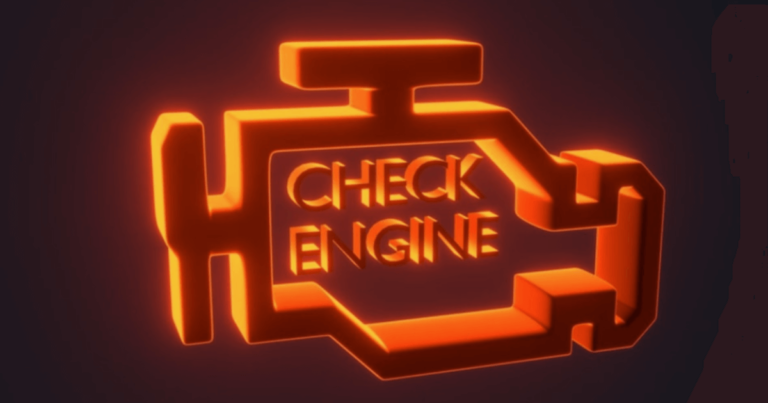Check Engine Light Flashing – What It Means & How to Fix It.
The check engine light is one of the most important warning indicators in your vehicle. When it flashes, it signals a serious issue that needs immediate attention. Unlike a steady check engine light (which suggests a minor issue) a flashing one typically points to engine misfires emission system failures or potential catalytic converter damage.
Ignoring it can lead to expensive repairs, poor fuel efficiency or even complete engine failure. So, let’s break down the main causes, how to fix them and what you should do when you see your check engine light flashing.
What Does a Flashing Check Engine Light Mean?
A flashing check engine light is a sign of a severe misfire, which means unburned fuel is entering the exhaust system. This can overheat the catalytic converter, leading to expensive damage or even a fire hazard. If your check engine light is blinking, stop driving immediately and diagnose the problem.
Key Difference:
- Steady check engine light = Minor issue (e.g., loose gas cap, faulty sensor).
- Flashing check engine light = Serious problem (e.g., engine misfire, catalytic converter failure).
Flashing vs. Solid Check Engine Light
| Light Type | Meaning | Action Needed |
|---|---|---|
| Solid Check Engine Light | Minor issue (sensor, emissions, gas cap) | Diagnose soon but not urgent |
| Flashing Check Engine Light | Severe issue (misfire, fuel system, catalytic converter) | Stop driving & fix immediately 🚨 |
If your check engine light is flashing do not continue driving! Pull over and diagnose the issue ASAP.
Top 6 Causes of a Flashing Check Engine Light
1. Engine Misfire (Most Common Cause)
An engine misfire happens when one or more cylinders fail to ignite fuel properly. This can cause rough engine performance, reduced fuel efficiency and potential damage to your catalytic converter. Symptoms of an engine misfire include loss of power, stalling, poor fuel economy and a rough idle. If the issue isn’t fixed quickly, it could lead to further damage.
🔧 Fix:
- Replace spark plugs if they’re worn out
- Check and replace ignition coils if faulty
- Use a fuel injector cleaner to remove carbon buildup
2. Faulty Oxygen (O2) Sensors
The oxygen sensor monitors the air-fuel ratio in your engine and sends data to the car’s computer for optimal performance. A bad O2 sensor can cause incorrect fuel adjustments, leading to misfires, increased emissions and poor fuel economy. Symptoms of a failing oxygen sensor include poor gas mileage, rough idling and delayed acceleration.
🔧 Fix:
- Use an OBD2 scanner to check for O2 sensor errors
- Replace the faulty sensor (cost: $100–$300 depending on the car)
3. Catalytic Converter Failure
The catalytic converter is responsible for reducing harmful emissions from your exhaust system. When it fails, it often overheats due to unburned fuel caused by engine misfires. A failing catalytic converter can cause a rotten egg (sulfur) smell, difficulty accelerating, and increased fuel consumption. If not fixed, it can severely impact your vehicle’s performance.
🔧 Fix:
- If caught early, fixing the misfire issue prevents further damage
- Otherwise, replacement is necessary (cost: $1,000+)
4. Failing Mass Airflow (MAF) Sensor
The MAF sensor helps regulate the air-fuel ratio in your engine. A failing sensor can disrupt combustion, leading to performance issues like stalling, black smoke from the exhaust and sudden loss of power. This can trigger the check engine light and cause the car to run inefficiently.
🔧 Fix:
- Clean or replace the MAF sensor
- Ensure the air filter is clean and unclogged
5. Fuel System Problems (Injectors, Pump, Filter)
Your car’s fuel system plays a crucial role in delivering the right amount of fuel to the engine. If the fuel injectors, pump, or filter are malfunctioning, it can lead to engine hesitation, hard starts and power loss during acceleration. A clogged fuel filter or dirty injectors can cause fuel delivery to become inconsistent, leading to misfires and poor performance.
🔧 Fix:
- Use fuel injector cleaner for minor clogs
- Replace fuel pump or filter if needed
6. Loose or Damaged Spark Plug Wires
Spark plug wires are responsible for transmitting electrical power to the spark plugs. If they are worn out, disconnected or damaged, the engine may experience random misfires, sudden power loss and a rough engine sound. Over time, heat and wear can cause these wires to crack leading to poor ignition performance.
🔧 Fix:
- Inspect spark plug wires for cracks or wear
- Replace if needed (cheap fix: $50–$150)
What to Do When Your Check Engine Light Is Flashing
Pull over safely: If your check engine light starts flashing while driving the first thing to do is to safely pull over as soon as possible. Continuing to drive with a flashing light can cause severe damage to your catalytic converter which can be very expensive to replace.
Turn off the engine: Once you’ve pulled over safely, turn off the engine immediately to prevent further damage. A flashing check engine light often signals a severe misfire that can overheat and destroy the catalytic converter. The longer the engine runs, the worse the damage can become.
Check for obvious issues: Before calling a mechanic, check for visible problems that might be causing the check engine light to flash. Some issues may be minor and easy to fix.
Common Quick Fixes to Check:
✔ Loose Gas Cap: A missing, loose, or damaged gas cap can trigger the check engine light. Tighten it securely and see if the light stops flashing after driving a few miles.
✔ Disconnected or Damaged Wires: Look under the hood for any loose, frayed, or damaged wires around the engine or battery. Electrical issues can cause misfires.
✔ Leaking Fluids: Check under the car for oil, coolant, or fuel leaks, which could signal a serious issue.
✔ Overheating Engine: If the temperature gauge is rising or you see steam, your engine may be overheating. Wait for the engine to cool down before doing anything.
Use an OBD2 scanner: If you have an OBD2 scanner, you can quickly retrieve the trouble codes from your car’s computer to diagnose the issue. These codes help pinpoint the exact problem and determine whether it’s a minor issue or something that requires a mechanic.
How to Use an OBD2 Scanner:
1️⃣ Plug the scanner into the OBD-II port, usually found under the steering wheel.
2️⃣ Turn the ignition to “ON” (don’t start the engine).
3️⃣ Follow the scanner’s instructions to read the error codes.
4️⃣ Look up the codes online or in the scanner manual to understand what they mean.
OBD2 Scanner Code Guide
| Code | Possible Issue |
|---|---|
| P0300 | Random/multiple misfire detected |
| P0301-P0306 | Misfire in a specific cylinder |
| P0420 | Catalytic converter issue |
| P0171/P0174 | Air-fuel mixture too lean |
Avoid driving: If your car is shaking, vibrating, stalling or struggling to accelerate, DO NOT continue driving. These symptoms mean your engine is not running properly, and further driving could lead to severe internal damage.
Prevent Future Check Engine Light Issues
✔️ Regular Maintenance – Change spark plugs and filters as recommended
✔️ Use High-Quality Fuel – Cheap fuel can cause engine deposits
✔️ Check Engine Codes Early – A $20 OBD2 scanner can save thousands
✔️ Keep Sensors Clean – Clean MAF and O2 sensors every 6–12 months
Final Thoughts
Your car’s flashing check engine light is a serious warning not just an annoying dashboard indicator. Ignoring it can turn a small problem into a major repair bill costing you thousands of dollars in engine or catalytic converter damage.
FAQs About a Flashing Check Engine Light
Can I drive with a flashing check engine light?
No! A flashing CEL means severe engine damage is possible. Stop driving and diagnose ASAP.
How much does it cost to fix a flashing check engine light?
Minor repairs (spark plugs, O2 sensor) = $50–$300 and Major repairs (catalytic converter, fuel system) = $1,000+
Will disconnecting the battery reset the check engine light?
Yes, but it won’t fix the problem! Diagnose the issue first.
How do I reset a flashing check engine light?
Fix the issue then use an OBD2 scanner to reset the code.





